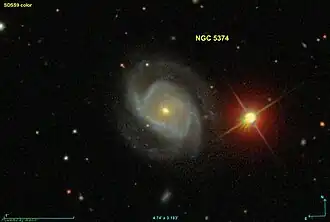NGC 5374
| NGC 5374 | |
|---|---|
 NGC 5374 imaged by SDSS | |
| Observation data (J2000 epoch) | |
| Constellation | Virgo |
| Right ascension | 13h 57m 29.6454s[1] |
| Declination | +06° 05′ 49.342″[1] |
| Redshift | 0.014483±0.00000787[1] |
| Heliocentric radial velocity | 4,342±2 km/s[1] |
| Distance | 224.16 ± 13.31 Mly (68.729 ± 4.081 Mpc)[1] |
| Group or cluster | NGC 5374 group (LGG 368) |
| Apparent magnitude (V) | 13.27[1] |
| Characteristics | |
| Type | SB(r)bc[1] |
| Size | ~113,900 ly (34.92 kpc) (estimated)[1] |
| Apparent size (V) | 1.7′ × 1.5′[1] |
| Other designations | |
| IRAS 13549+0620, UGC 8874, MCG +01-36-004, PGC 49650, CGCG 046-016[1] | |
NGC 5374 is a barred spiral galaxy in the constellation of Virgo. Its velocity with respect to the cosmic microwave background is 4,612±19 km/s, which corresponds to a Hubble distance of 221.9 ± 15.6 Mly (68.02 ± 4.77 Mpc).[1] Additionally, seven non-redshift measurements give a similar mean distance of 224.16 ± 13.31 Mly (68.729 ± 4.081 Mpc).[2] It was discovered by German-British astronomer William Herschel on 12 May 1793.[3][4]
NGC 5374 is a is a radio galaxy, i.e. it has giant regions of radio emission extending well beyond its visible structure.[5]
NGC 5374 group
According to A. M. Garcia, NGC 5374 is the namesake of a group of galaxies. The NGC 5374 group (also known as LGG 368) contains at least eight galaxies, including NGC 5382, NGC 5384, NGC 5386, NGC 5417, NGC 5418, NGC 5434, and UGC 8906.[6]
Supernovae
Three supernovae have been observed in NGC 5374:
- SN 2003bl (Type II, mag. 18.4) was discovered by LOTOSS (Lick Observatory and Tenagra Observatory Supernova Searches) on 2 March 2003.[7][8]
- SN 2010do (Type Ic, mag. 17.2) was discovered by L. A. G. "Berto" Monard on 2 June 2010.[9][10]
- SN 2016P (Type Ic-BL, mag. 16) was discovered by Grzegorz Duszanowicz and Michal Zolnowski on 19 January 2016.[11]
See also
References
- ^ a b c d e f g h i j k "Results for object NGC 5374". NASA/IPAC Extragalactic Database. NASA and Caltech. Retrieved 7 August 2025.
- ^ "Distance Results for NGC 5374". NASA/IPAC EXTRAGALACTIC DATABASE. NASA. Retrieved 7 August 2025.
- ^ Herschel, William (1802). "Catalogue of 500 New Nebulae, Nebulous Stars, Planetary Nebulae, and Clusters of Stars; with Remarks on the Construction of the Heavens". Philosophical Transactions of the Royal Society of London. 92: 477–528. Bibcode:1802RSPT...92..477H. doi:10.1098/rstl.1802.0021.
- ^ Seligman, Courtney. "New General Catalogue Objects: NGC 5374". Celestial Atlas. Retrieved 7 August 2025.
- ^ "NGC 5374". SIMBAD. Centre de données astronomiques de Strasbourg. Retrieved 6 August 2025.
- ^ Garcia, A. M. (1993). "General study of group membership. II. Determination of nearby groups". Astronomy and Astrophysics Supplement Series. 100: 47. Bibcode:1993A&AS..100...47G.
- ^ Swift, B.; Weisz, D.; Li, W.; Boles, T. (2003). "Supernovae 2003bj, 2003bk, 2003bl, and 2003bm". International Astronomical Union Circular (8086): 1. Bibcode:2003IAUC.8086....1S.
- ^ "SN 2003bl". Transient Name Server. IAU. Retrieved 7 August 2025.
- ^ Monard, L. A. G. (2010). "Supernova 2010do in NGC 5374". Central Bureau Electronic Telegrams (2301): 1. Bibcode:2010CBET.2301....1M.
- ^ "SN 2010do". Transient Name Server. IAU. Retrieved 7 August 2025.
- ^ "SN 2016P". Transient Name Server. IAU. Retrieved 7 August 2025.
External links
 Media related to NGC 5374 at Wikimedia Commons
Media related to NGC 5374 at Wikimedia Commons- NGC 5374 on WikiSky: DSS2, SDSS, GALEX, IRAS, Hydrogen α, X-Ray, Astrophoto, Sky Map, Articles and images